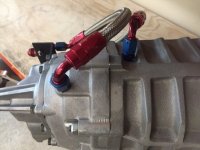Trans Mainshaft Bearings: circulating oil is the best solution to extending mainshaft bearing life in any MD, S4/S5, S4D/S5D transaxle. Bearing is in front of trans and high out of the oil, what happens when you are accelerating up hill? (Hint: oil runs to back of trans). Pump keeps oiling that bearing in all instances.
Temp Switch: We used to have a 125º switch, had more pumps come back with burned up motors from oil too cold. Pump motor manufacture told us to start pumps with less load on them. Now we use 150º switches. Not ideal, but it's what seems to work.
Warm ups: Always best to warm up engine and trans with some light duty driving before driving hard. Engines and transmissions are designed to be operated at 180º-220º. Housing bores (bearings, pistons, etc) are tight when running at room temp. They loosen up at operating temps for best operation and least resistance.


